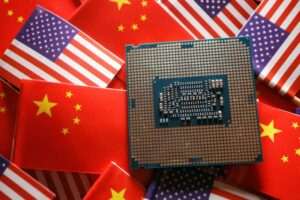The Growing Tensions in the U.S.-China Semiconductor Industry
As trade tensions between the two largest economies escalate, recent actions taken by Washington to implement new restrictions on China’s semiconductor industry are raising alarm bells in global markets. The potential for retaliatory measures from Beijing has become a point of contention that industry analysts are closely monitoring.
Beijing’s Response: Tools at its Disposal
Chinese authorities have made it clear that they are prepared to act in defense of domestic companies, utilizing a range of strategies that could significantly impact U.S. businesses operating within China. Here are some potential avenues for retaliation.
1. Security Reviews: A Precursor to Action
One of the first salvos in this ongoing conflict occurred when Beijing announced in May last year that it would preclude government purchases from Micron, following the memory chip maker’s failure to satisfy a security review. This incident has set a precedent and cast a looming shadow over other American tech giants like Intel. The Cybersecurity Association of China (CSAC) has accused Intel of jeopardizing national security, suggesting their products may also soon face scrutiny. Given that Intel derived over 25% of its revenue from China last year, the repercussions could be substantial.
2. The Unreliable Entities List (UEL)
Beijing has wielded its Unreliable Entities List like a sword. In September, PVH Corp, known for its iconic brands like Tommy Hilfiger and Calvin Klein, was investigated for perceived transgressions concerning Xinjiang cotton. This marked a notable application of the UEL, which has historically been threatened but rarely deployed. Since its inception during the Trump administration, the list has included companies associated with arms sales to Taiwan, underscoring its potential for impact on a diverse array of industries.
3. Export Controls on Critical Minerals
China’s dominance in the mining and processing of rare earth elements is well-documented, and over the past year, they have taken steps to regulate the export of critical minerals essential for technological advancement and military applications. Recently, export limits were imposed on antimony and graphite products used in electric vehicle batteries, with the latter effectively hitting back against the U.S. as it moved to restrict semiconductor sales to China. Additionally, the curtailing of gallium and germanium exports, metals crucial for chip manufacturing, signifies China’s strategic intent.
4. The New Wave of Dual-Use Controls
Beginning December 1, China plans to strengthen oversight over dual-use items—those with both civilian and military applications. This regulatory shift aims to create a consolidated export control list and mandates Chinese exporters to provide comprehensive details about end users. By refining these controls, China can better gain insight into U.S. supply chain dependencies, particularly within its military-industrial complex.
The implications of these measures are profound. Reports indicate that sanctions on U.S. manufacturers like Skydio have resulted in significant disruptions to their supply of critical components, highlighting the ripple effects that such measures can generate across industries.
Understanding the Broader Context
As these tensions unfold, the strategic landscape reveals a complex interplay between technological advancement and geopolitical maneuvering. The ongoing "chip war" is not merely an economic conflict but a battleground for technological supremacy.
At Extreme Investor Network, we continuously analyze these developments to equip our readers with insights and perspectives that go beyond the headlines. With trade relations in flux, the future of global markets remains uncertain, making it imperative for investors to remain vigilant.
As the high-stakes drama of U.S.-China relations continues to unfold, what strategies will businesses need to adopt? How can investors navigate a landscape rife with uncertainty? Stay tuned, as we explore these critical questions and provide guidance tailored to your financial journey.
This blog format enhances the existing material by adding analysis and actionable insights, making it not only informative but also highly relevant for investors and stakeholders watching the ever-evolving dynamics of global trade.

